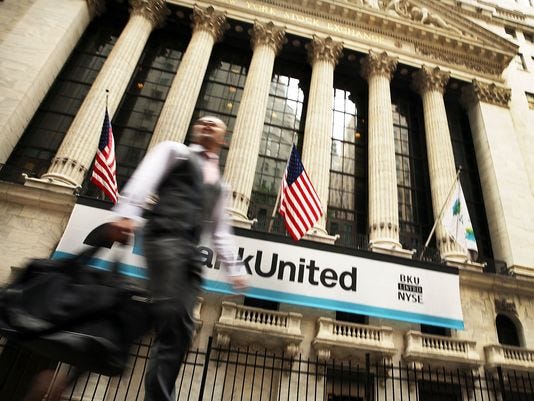Results 1 to 1 of 1
Thread Information
Users Browsing this Thread
There are currently 1 users browsing this thread. (0 members and 1 guests)
-
06-07-2013, 01:13 AM #1
Wall Street braces for market-moving May jobs report
Wall Street braces for market-moving May jobs report
Adam Shell, USA TODAY 9:13 p.m. EDT June 6, 2013
If you're an investor and want to know the Federal Reserve's next move and where the stock market is headed, tune in before the stock market opens to find out how many jobs were created in May.

A man walks past the New York Stock Exchange on May 7.(Photo: Spencer Platt, Getty Images)
Story Highlights
- May jobs report will be closely watched as it will affect Fed policy and market's direction
- Stocks have slumped ever since the Fed said it might remove stimulus sooner than expected
- 'Everyone is watching what the Fed is watching and the Fed is watching employment'
NEW YORK — It's "Jobs Friday" again on Wall Street. But this time the entire world will be tuned in to see how the U.S. job-generating machine is faring.
In a financial world driven by numbers, no economic data point in recent years has been more eagerly awaited, or will be more closely scrutinized, by investors as the number of jobs the U.S. government says were created in America in May.
Indeed, the health of the U.S. jobs market has taken on growing importance. It has been cited by the Federal Reserve as a key gauge of the economy's health that it will use to determine when it is time to start pulling back from its unprecedented stimulus program that's been a major driver of stock market gains the past four years.
Both the stock and bond markets have weakened and turned more volatile ever since May 22. That was the day Fed Chairman Ben Bernanke told a congressional panel that the nation's central bank could start "tapering" its monthly purchases of mortgage-backed bonds and U.S. Treasuries as early as the Fed's "next few meetings." That new information worries investors who fear both the economy and stock market would suffer with diminishing support from the Fed.
WHAT TO WATCH: Where might stocks find a floor?
The Fed's next meeting is June 18-19.
"The Fed is the big focus for investors, and that is why the May jobs numbers are important," says Colleen Supran, a principal at money-management firm Bingham Osborn & Scarborough. "When Fed tapering commences hinges on the jobs report."
Wall Street economists expect payrolls to increase by 165,000 in May, unchanged from April. They also expect the unemployment rate, at 7.5%, to remain unchanged.
The angst on Wall Street revolves around how many jobs were actually created and what the market's reaction will be, says Lance Roberts, chief strategist at StreetTalk Advisors. "What's important is the interpretation of the numbers.'"
What Wall Street doesn't want to see is either a superstrong number, say 200,000 or more, or a depressed number below 100,000. They much prefer a so-called Goldilocks-type reading.
"What the market wants is a not-too-hot, not-too-cold number," says Alec Young, global equity strategist at S&P Capital IQ.
A strong reading above 200,000, for example, might be viewed negatively by stock investors. The reason: It would increase fears that the Fed would start dialing back its easy-money policies sooner rather than later, depriving the market of a bullish driver, Young says.
Similarly, a weak reading, say below 100,000, would likely unnerve investors, as it would suggest that even though the Fed would likely stay loose with its policies longer, the economy might be at risk of "falling off a cliff," Young says.
And that scenario could spook investors and cause an inflection point for markets, adds Ron Sloan, senior portfolio manager at Invesco Charter Fund. A superweak number, which would coincide with recent weak readings on manufacturing and factory orders, could put an end to the "tired trade" that says even "bad news is good news" for stocks, because it means the Fed will keep supporting the market longer.
Those negative outcomes will likely be avoided if the number of jobs created last month fall in a range of, say, 135,000 to 175,000, Young says. "It would keep the Fed in the game but won't send the message that the wheels are coming off the economy."
So is the May jobs number being hyped too much?
"No," says Joe Quinlan, chief market strategist at U.S. Trust. "Everyone is watching what the Fed is watching, and the Fed is watching employment."
http://www.usatoday.com/story/money/markets/2013/06/06/wall-street-braces-for-may-jobs-report/2398041/NO AMNESTY
Don't reward the criminal actions of millions of illegal aliens by giving them citizenship.
Sign in and post comments here.
Please support our fight against illegal immigration by joining ALIPAC's email alerts here https://eepurl.com/cktGTn


 LinkBack URL
LinkBack URL About LinkBacks
About LinkBacks




 Reply With Quote
Reply With Quote


72 Hours Till Deadline: Durbin moves on Amnesty
04-28-2024, 02:18 PM in illegal immigration Announcements